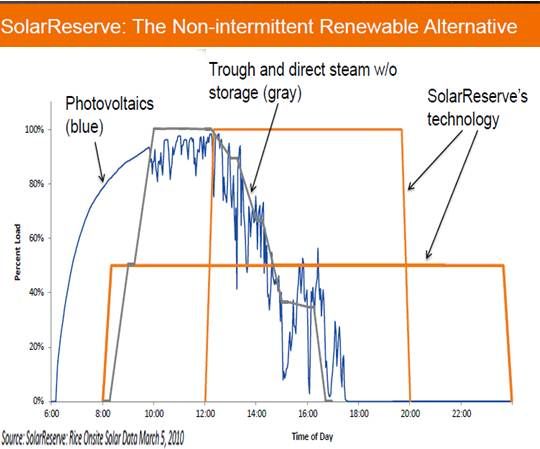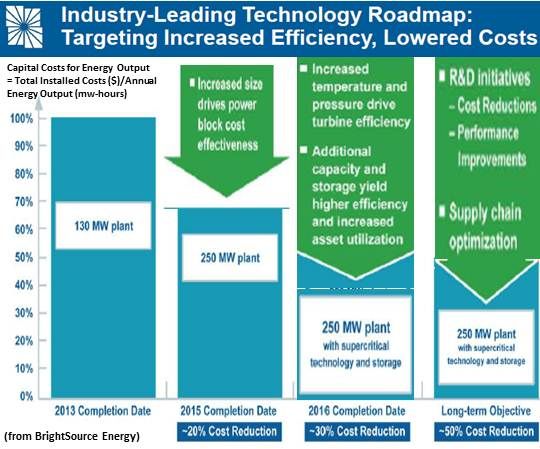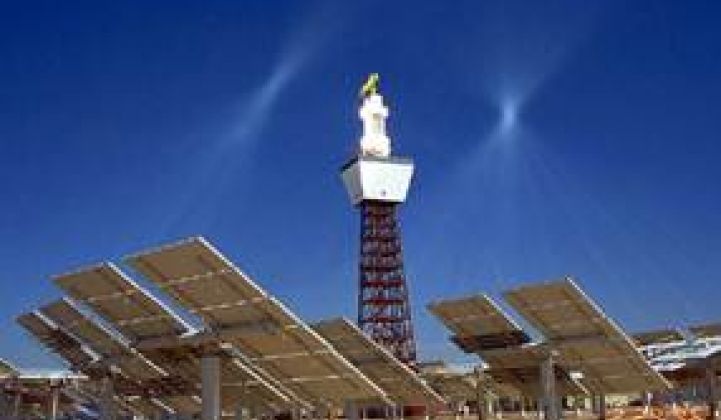Note: SolarReserve’s question was raised in The CSP Storage Technology Race Heats Up: Is SolarReserve CEO Kevin Smith Right About BrightSource’s Steam-to-Salts Storage?
SolarReserve (SR) flows molten salts to a solar receiver at the top of a tower, where heliostats focus the sun to heat the molten salts to over 1,000 degrees Fahrenheit.
Some of the molten salts flow through a heat exchanger to boil water into steam that drives a turbine and generates electricity. The unused salts are stored in an insulated tank. When there is no sun, the salts can be released to create more steam to generate more electricity.
BrightSource Energy (BSE) flows pressurized steam to the boiler at the tower’s top, where heliostat-reflected sun heats it to over 1,000 degrees. Some flows down to drive an electricity-generating turbine and the rest flows through a heat exchanger to heat molten salts for storage.
“Steam is the wrong thing to use to heat salt. You should be using the sun’s energy to heat salt. A steam-to-molten-salt heat exchanger is not very cost-effective or efficient,” SR CEO Kevin Smith told GTM. “They go from steam to salt and back to steam. Why would you do that?”
At GTM’s request, BSE Director Benyamin Koretz talked about Smith’s question.

Prototypes of both systems were built and tested by SR backer Rocketdyne (now United Technologies [NYSE:UTX]) in the '80s and '90s, Koretz explained. The molten salt system worked “a little better.”
BrightSource, Koretz said, “needed a technology the financial community could understand. Steam boilers had been around for 100 years. The molten salt technology has some advantages and disadvantages, but it doesn’t have that track record.”
An advantage of heating molten salts, Koretz acknowledged, “is they can flow directly into the storage system and you don’t need to heat the salts with steam. It works and is pretty efficient.”
But “to pump molten salt 600 feet up into the air, you need a lot of electricity,” Koretz said. “You’re talking about at least 5 percent of the electricity out of your turbine, just to pump the salt to the tower top.” BSE’s steam system is pressure-driven. “Except for startup, you’re not using electricity.”
BSE estimates the parasitic loss at its Ivanpah facility will be approximately 6 percent, including the power block loss that was not part of Koretz’s 5 percent loss estimate for molten salt technology. “Steam has a smaller parasitic effect because it is much lighter than salt and much less viscous,” Koretz said. “And you are using energy before you’ve thrown away more than half of it in the power block.”
Another molten salt inefficiency is spillage, Koretz said, which is “the reflected sunlight that misses the receiver.” Spillage is inevitable because of heliostat aiming error and flux at the edges of the receiver.
“A molten salt receiver will always have higher spillage,” Koretz explained, “because the size of the receiver is always a tradeoff between heat losses if it is too big and spillage if it is too small.” Molten salts have to be stored at approximately 500 degrees Fahrenheit to prevent them from freezing, so the system runs hotter and the boiler must be “on the smaller side,” Koretz said, to reduce heat loss.
“I don’t believe we have an efficiency advantage or disadvantage versus molten salts because there are too many variables,” Koretz said. But the bottom line is always going to be cents per kilowatt-hour. Highest efficiency doesn’t translate to lowest cost.”
The $0.135 per kilowatt-hour power purchase agreement (PPA) price for the electricity from SR’s 110-megawatt Crescent Dunes project, which will have ten hours of storage, was made public by offtaker Nevada Power.
Prices in BSE’s contracts with Southern California Edison (SCE) are confidential. The company suggested there is some indication its cents-per-kilowatt-hour offering is lower than its rivals’ because those PPAs, including one for a 250-megawatt tower at its Sonoran West site with two hours of storage, were won in competitive bidding. But the identity of the competitors that BSE bested for those contracts is confidential.

Both technologies have similar storage capacities, Koretz said. “The optimal number of hours is decided by the needs of the off-taker and the relative value of the additional energy and additional operational flexibility.”
Ivanpah will be BSE’s most expensive plant, Koretz said. “We see our costs going down substantially. I don’t know anything about our competitors’ future costs, but we would develop a molten salt receiver ourselves if we were convinced it was a viable and cost-competitive technology in the long run.”
To produce cheaper electricity, BSE is making its heliostats and solar field cheaper, and it will double the size of the power block at its next project and get higher temperatures than the current generation of molten salts is capable of, Koretz said. “Ultimately, you get beyond 600 degrees Celsius and the pressure goes beyond 250 bar to supercritical. That is our goal in the long term.”
CSP projects will have to be larger to remain cost-competitive, Koretz said. “There is no intrinsic reason a molten salt project should be more expensive. Doubling the size would achieve similar cost savings.”
It’s all about a few percentage points in efficiency, Koretz said. “From 42 percent to 44 percent is almost a 5 percent increase for the same solar field. Cents per kilowatt-hour is the bottom line.”



